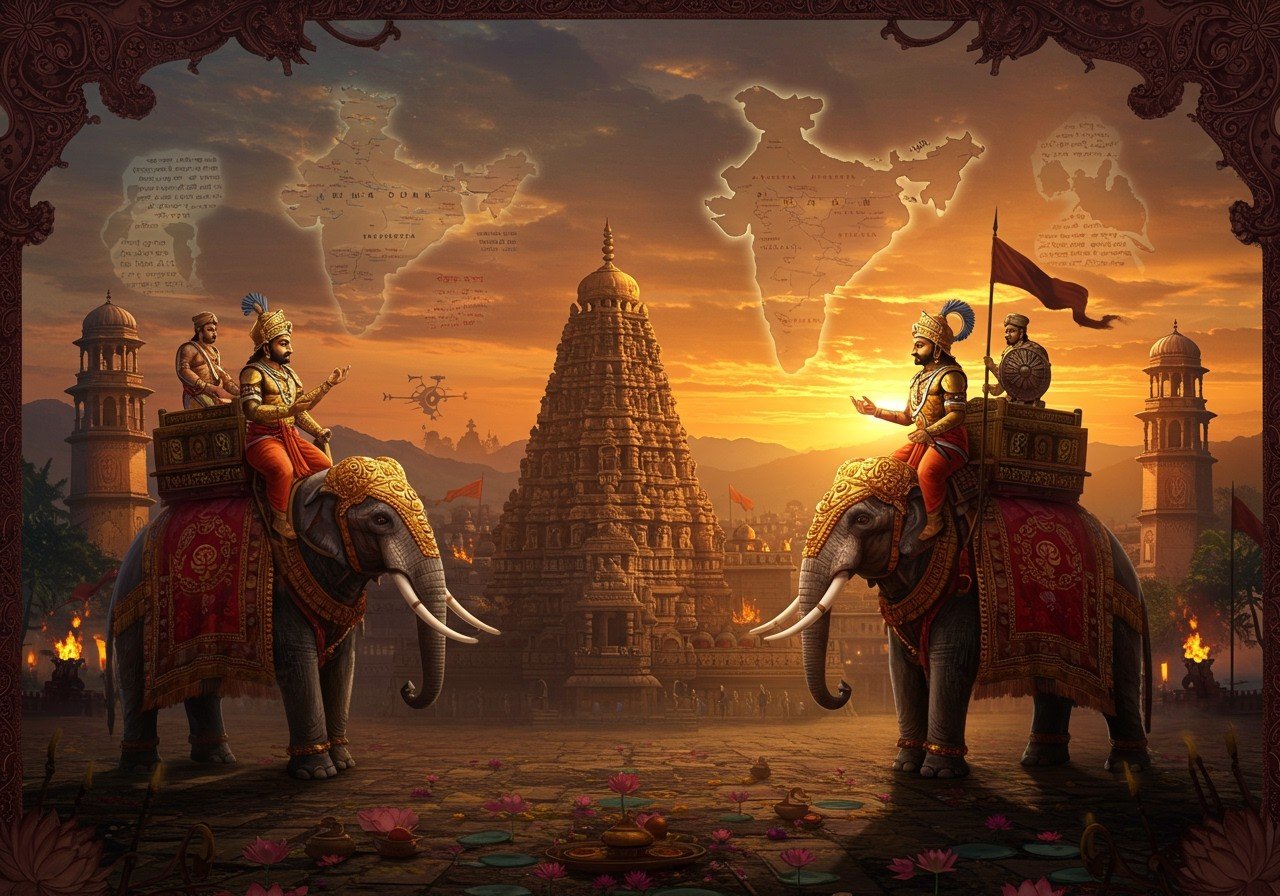
The Chalukya Dynasty, a prominent power in southern and central India from the 6th to the 12th centuries CE, engaged in a complex web of wars and alliances that shaped the political and cultural landscape of the region. Their interactions with powerful neighbors like the Cholas and Rashtrakutas, as well as other kingdoms, left a lasting legacy on India’s history.
Chalukya and Chola Dynasties: A Legacy of Conflict and Exchange (992 CE – 1120 CE)
The Chalukya-Chola rivalry stands out as a defining period in South Indian history. The Cholas, known for their maritime strength and territorial ambitions, frequently clashed with the Chalukyas for control of the resource-rich Deccan region. The Eastern Chalukya kingdom of Vengi, located in modern-day Andhra Pradesh, became a focal point of this protracted conflict due to its strategic importance and shifting alliances with both the Western Chalukyas of Kalyani and the Cholas.
- Early Conflicts (992 CE – 1070 CE): The Chalukya-Chola wars began in the late 10th century, stemming from both dynasties’ desire for regional dominance and control over vital trade routes. These early clashes set the stage for a series of battles that would span over a century.
- Key Battles and Figures: The Battle of Takkolam in 949 CE, though predating the main Chalukya-Chola wars, foreshadowed the intense rivalry to come. Later, figures like Rajaraja Chola I and Vikramaditya VI played crucial roles in shaping the conflict, leading campaigns and counter-campaigns that significantly impacted both empires.
- Impact: The Chalukya-Chola wars resulted in significant loss of life and resources, impacting the political stability and economic prosperity of the region. Despite the conflicts, periods of peace and cultural exchange also occurred, particularly in the realms of art and architecture, demonstrating the complex relationship between these two powerful dynasties.
Chalukya and Rashtrakuta Dynasties: A Power Struggle in the Deccan (543 CE – 1189 CE)
The Chalukya relationship with the Rashtrakutas represents another significant chapter in their history. The Rashtrakutas, who rose to prominence in the 8th century CE, challenged Chalukya dominance in the Deccan. This power struggle resulted in a series of wars and shifting alliances.
- Rise of the Rashtrakutas (c. 753 CE): Dantidurga, a Rashtrakuta ruler, led a revolt against the Chalukyas, culminating in the Battle of Kanchi in 753 CE. This victory marked the beginning of Rashtrakuta dominance in the Deccan, displacing the Chalukyas for over two centuries.
- Chalukya Resurgence (c. 973 CE): Tailapa II, a Chalukya king, successfully led a campaign to reclaim their lost territories from the declining Rashtrakuta empire in the late 10th century. This marked the beginning of the Later Chalukya or Kalyani Chalukya era.
- Legacy: The Chalukya-Rashtrakuta conflict significantly impacted the political and cultural landscape of the Deccan. Despite the wars, both dynasties contributed immensely to the region’s art, architecture, and literature, leaving behind a rich cultural heritage.
Chalukya Interactions with Other Kingdoms
Beyond their major conflicts with the Cholas and Rashtrakutas, the Chalukyas also interacted with a multitude of other kingdoms, both large and small. These interactions included wars, alliances, and cultural exchanges.
- Eastern Chalukyas of Vengi (624 CE – 1070 CE): The Eastern Chalukyas, a branch of the main Chalukya dynasty, ruled the Vengi region. Their relations with the Western Chalukyas and other neighboring kingdoms like the Cholas played a crucial role in the political dynamics of South India.
- Other Dynasties: The Chalukyas also interacted with dynasties like the Eastern Gangas, Kakatiyas, Hoysalas, and Pallavas, engaging in both conflict and cooperation depending on the political climate and strategic considerations.
- Impact: These interactions further shaped the political landscape and contributed to the cultural diversity of the region. The Chalukyas influenced smaller kingdoms, disseminated architectural styles, and fostered artistic and literary developments.
Poojn.in: Connecting You to India’s Rich Cultural Heritage
Poojn.in, India’s leading online store for cultural goods and services, offers a wide range of products that connect you to the rich heritage of the Chalukya Dynasty and other historical periods. Explore our authentic collection of puja items, including Ashoka Bark (available as Ashokarn, Ashoka Chaal, and Ashoka Chhal), and experience the traditions that have shaped India’s spiritual landscape.
Explore Bel Mala at Poojn.in
Discover Tulsi Mala at Poojn.in
Conclusion
The Chalukya Dynasty’s legacy is intertwined with the wars and alliances they forged over centuries. Their interactions with neighboring kingdoms shaped the political map of South India, fostered cultural exchange, and contributed to the rich tapestry of Indian history. By understanding these complex relationships, we gain valuable insights into the forces that shaped the region’s past and continue to influence its present.


